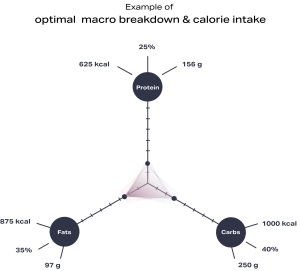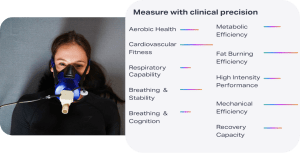Metabolic slowdown and why you should care about it.
You have undoubtedly heard of the term metabolism. Although most people don’t know what it means, it is often the culprit for failed weight loss attempts or general inability to achieve a fitness goal. This blog explains what metabolism is, why it’s important to maintain it at high levels, and what can cause it to decline.
What is metabolism?
Metabolism includes all biological processes that convert fuel from nutrients like fats and carbohydrates into the energy our body needs to survive. This energy is what we refer to as calories. In simple terms, it’s the process through which we burn calories. It is the most vital biological process since it provides a constant supply of the energy needed to power your body movements and all functions keeping you alive such as breathing, blood circulation, cell growth, muscle reparation, etc. Metabolism differs significantly from one person to another because of age, genetics, exercise habits, nutrition preferences, medication, etc.
Why it’s important to have a high metabolism.
A high metabolism means your body burns more calories than the average person with the same age, weight, height, and gender. Conversely, having a slow metabolism means you are burning fewer calories than the norm. Since weight loss requires a caloric deficit, the state when you eat fewer calories than you burn, having a high metabolism is the most powerful protection against obesity. However, besides protecting you from weight gain, having a high metabolism is associated with faster cellular and muscle tissue reparation and other healing processes vital to recovery after training. Therefore, a high metabolism is also essential for avoiding injuries. 
What can cause my metabolism to slowdown?
Aging, nutrition, and training are the most potent drivers of your metabolism and can all lead to a metabolic decline. Here’s how each one can affect it.
Age: Aging will cause your metabolism to decline since the older we get, the harder it is to maintain muscles mass and the less metabolism-boosting hormones (e.g., growth hormone) we secrete. The metabolic decline caused by aging is much less acute than the one nutrition or training can cause, and in most cases, it’s responsible for only a small portion of a person’s weight gain. Moreover, despite the decline it causes, training and exercise can help reverse it and maintain your metabolism at healthy levels.
Nutrition: Nutrition is one of the most powerful drivers of your metabolism. When you reduce the calories you consume and enter into a calorie deficit, the state in which you burn more calories than you eat, your body will reduce its metabolic activities in two ways. First, it sheds muscle mass. This process occurs since muscles are one of your primary energy reserves that will be tapped upon to cover the calorie deficit caused by food restriction. Second, it makes your remaining muscle mass more economical, causing it to burn fewer calories when moving (e.g., walking). This is done by changing the balance of specific hormones that regulate the energy your cells burn during movement. Both processes are part of your body’s survival mechanism and kick in to conserve calories and help you close the energy deficit caused by restricting food intake. However, both can be averted with the correct dose and type of exercise.

Training: Training can affect your metabolism in the fastest and most acute way. Although it can be a powerful tool for increasing your metabolism, over-training can have the opposite effect. The most effective workout type for increasing your metabolism is resistance training. First, it increases your muscle mass, leading to more calorie burn as more active tissue requires more energy. Second, it increases the energy your muscles burn on a per unit basis, meaning that every pound of muscle mass starts to burn more due to a positive shift in the hormone balance regulating your cells’ energy consumption. Too much training, however, has been shown to cause an adverse change in hormone balance (e.g., reduction of growth hormone secretion) that reduces metabolic processes. In this case, metabolic decline and the associated decrease in recovery capacity pose a critical danger for injuries.
Conclusion
A metabolic slowdown can pose a severe obstacle in achieving your dream physique and staying healthy long-term. As a result, one of the most important things to monitor is whether your metabolism has slowed down or whether your current fitness and nutrition are causing it to decline. The PNOE metabolic analyzer provides a clinical-grade analysis of your metabolism, helping you act early and avoid the pitfalls of a metabolic slowdown.
Part two…
The importance of training zones for health and performance
You must have probably heard of heart rate training zones and how elite endurance athletes, and more recently, a growing number of recreational athletes, use them to guide their training.
This blog explains why they are important for your training and how each one can help your body evolve in different directions.
What are heart rate zones?
Heart rate training zones reflect your body’s metabolic statuses in different training intensities. They are heart rate ranges (e.g., 123 – 142 beats per minute), each one corresponding to an exercise intensity, where your body responds metabolically in a specific way. Two factors determine the metabolic state of your body in each zones:
- The fuel mixture used (i.e., the balance between fats and carbohydrates).
- The physical traits your body develops when training in this zone.
For example, when training in zone 2, your body will burn the most fat and enhance its cellular health fat-burning capabilities at the fastest rate.
What’s our body’s fuel mix, and how does it help determine training zones?
During exercise, your body typically burns a mixture of fats and carbohydrates to release the energy required (i.e., calories) to move. Fat releases more energy than carbs when burnt (i.e., 9 kcal per gram of fat vs. 4 kcal per gram of carbs) but has a slower burning process making it suitable for low exercise intensities where the rate of energy demand is low. Carbohydrates, on the contrary, require less time to burn and can therefore support higher exercise intensities where the rate of energy demand is larger. The mix of fats and carbohydrates used by your body is revealed by the breakdown of oxygen and carbon dioxide in your breath and is measured through the use of a metabolic analyzer like PNOĒ. Figure 1 shows the difference between fat and carbohydrate burn as exercise intensity increases during a treadmill test.
Figure 1 Dark green: fats, Turquoise: carbohydrates, Light green: heart rate
Since this measurement requires you to wear a mask, information for your body’s fuel usage becomes almost impossible to obtain during everyday training. As a result, we use heart rate as a proxy metric to accurately estimate our body’s fuel usage and metabolic status. This is done through a metabolic test whereby measuring heart rate and the fat-carbohydrate mix you can establish the correlation between fuel mix and heart rate. We refer to this as “getting your personalized training zones”. However, it’s important to note that the correlation between heart rate and fat-carbohydrate balance depends largely on the type of exercise. For example, you may be burning 30% fats and 70% carbs at 140 beats per minute when running but only 15% fats and 85% carbs at 140 beats per minute when cycling.
How many training zones do we use? What physiological traits does each one train?
The 5 zones system is the most frequently used one, accurately capturing the difference in metabolic states while remaining practical enough for everyday usage. Each zone is used for a different purpose as it inflicts different metabolic adaptations on your body.
Zone 1
Training intensity is typically used for warmup or active recovery (i.e. recovering from intense exercise while moving)
Zone 2
Zone 2 training will develop your mitochondrial function and improve your fat-burning efficiency. It’s highly recommended for long-range endurance sports as well as for individuals suffering from metabolic syndrome (e.g. Type II Diabetes). The improved mitochondrial function will also significantly support recovery capacity helping you to recover faster after intense bouts of exercise.
Zone 3
Zone 3 training can help strengthen your pulmonary muscles and improve cardiovascular function. It’s an ideal intensity when suffering from a lung or heart problem since its moderate- intensity offers a strong stimulus to the heart and lungs without being exhausting or overly strenuous.
Zone 4
Zone 4 training will help improve your VO2max and ability to sustain high-intensity exercise for prolonged durations by improving lactate shuttling. Lactate is a byproduct of anaerobic metabolism, which can also be used as fuel by your muscles. For as long as your body can clear fatigue byproducts faster than their being produced, the exercise intensity remains sustainable. As a result, the greater your lactate shuttling capability the greater your ability to sustain high exercise intensities for long periods of time.
Zone 5
Zone 5 training will improve your VO2max and peak power output capability (e.g. maximum speed or cycling wattage). This exercise intensity is sustainable for 60 to 120 seconds and requires one to train at his maximum potential.
Why should I care about training zones?
Regardless of age, gender, and fitness level, every person has one or more systems posing a limitation to fitness or health. Targeting these limitations effectively requires the precision that stems from focusing your cardio and interval training to the zone(s) that will bring about the adaptations needed to overcome them. 
The PNOE metabolic analyzer provides gold-standard accuracy in determining your training zones along with the plan that puts them to effective use. Understanding how your body responds metabolically differently and building your program around your metabolism is a foundational step toward maximizing your workout’s efficiency and achieving your health or performance goals faster and less effort.
